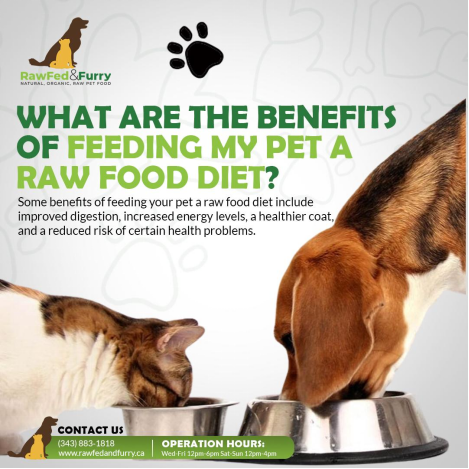Last Updated on June 9, 2024 by Dogs Vets
Introduction
Why Raw Dog Food is Gaining Popularity Among Pet Owners
In recent years, raw dog food has become a trending topic among pet owners who are keen on providing the best nutrition for their furry friends. Unlike traditional dog food, raw dog food aims to replicate the natural diet of wild canines, offering a more biologically appropriate choice.
This comprehensive guide will delve into everything you need to know about raw dog food and how it compares to traditional dog food options.
What is Raw Dog Food?
Definition and Components
Raw dog food consists of uncooked ingredients that closely mimic the natural diet of wild dogs. This type of food typically includes raw meat, bones, organs, and sometimes vegetables and fruits. The aim is to provide a balanced and nutritionally complete diet without the need for artificial additives or preservatives.
Types of Raw Dog Food
There are two main types of raw dog food: commercial and homemade. Commercial raw dog food is pre-packaged and sold by reputable brands, ensuring a balanced nutritional profile. Homemade raw dog food, on the other hand, allows pet owners to have complete control over the ingredients but requires careful planning to ensure nutritional adequacy.
Benefits of Raw Dog Food

Mimics Natural Diet
Raw dog food replicates the diet of wild canines, providing a more natural and biologically appropriate choice. This can lead to numerous health benefits, including improved digestion and nutrient absorption.
Nutritional Advantages
Raw dog food is rich in essential nutrients such as proteins, fats, vitamins, and minerals. These nutrients are often found in higher concentrations in raw food compared to processed dog food.
Health Benefits
Feeding your dog a raw diet can lead to several health improvements, including:
● Improved Digestion: Raw food is easier for dogs to digest, reducing issues like bloating and gas.
● Healthier Skin and Coat: The natural oils and fats in raw food can lead to a shinier coat and healthier skin.
● Increased Energy Levels: Dogs on a raw diet often exhibit higher energy levels and improved overall vitality.
Chemical-Free
One of the significant advantages of raw dog food is the absence of artificial preservatives, additives, and harmful chemicals commonly found in commercial dog foods.
Comparing Raw Dog Food to Traditional Dog Food
Nutritional Content
Raw dog food generally contains higher levels of essential nutrients compared to kibble and canned food. Traditional dog food often includes fillers and artificial ingredients that can dilute the nutritional value.
Health Impacts
While traditional dog food is convenient, it may contribute to long-term health issues such as allergies, obesity, and digestive problems. Raw dog food, on the other hand, aims to prevent these issues by offering a more natural diet.
Cost Comparison
Raw dog food can be more expensive than traditional dog food, but the long-term health benefits may offset the initial cost. Investing in your dog’s health now can save you money on veterinary bills later.
Convenience
Traditional dog food is undoubtedly more convenient to store and serve. However, with proper planning, raw dog food can be equally manageable. Many commercial raw dog food brands offer pre-packaged options that are easy to store and serve.
Nutritional Needs of Dogs
Essential Nutrients
Dogs require a balanced diet that includes proteins, fats, carbohydrates, vitamins, and minerals. Raw dog food naturally provides these nutrients in their most bioavailable form.
Age and Breed Considerations
Different breeds and life stages have varying nutritional needs. Puppies, for example, require more protein and fat for growth, while senior dogs may need fewer calories but more joint-supporting nutrients.
Common Nutritional Deficiencies
Feeding a raw diet can help address common nutritional deficiencies found in traditional dog foods, such as low levels of omega-3 fatty acids and certain vitamins.
How to Transition Your Dog to a Raw Food Diet
Step-by-Step Guide
Transitioning your dog to a raw food diet should be done gradually to avoid digestive upset. Start by mixing small amounts of raw food with their current diet, gradually increasing the proportion of raw food over a week or two.
Monitoring Health
Keep an eye on your dog’s health during the transition. Look for signs of improved digestion, energy levels, and coat condition. If you notice any adverse reactions, consult your veterinarian.
Common Challenges
Some dogs may be hesitant to try raw food initially. Patience and persistence are key. You can also try different types of raw food to find what your dog prefers.
Common Concerns and Misconceptions
Safety Concerns
One of the primary concerns about raw dog food is safety. It’s crucial to handle raw food properly to avoid contamination. Always wash your hands and utensils thoroughly and store raw food at the correct temperature.
Nutritional Balance
Ensuring a balanced diet is another concern. Commercial raw dog food brands like those offered by Raw Fed and Furry are formulated to meet nutritional standards. If you opt for homemade raw food, consider consulting a veterinary nutritionist.
Veterinary Opinions
While some veterinarians are skeptical about raw diets, many acknowledge the benefits when done correctly. It’s essential to discuss your plans with your vet to ensure your dog’s specific needs are met.
Choosing the Right Raw Dog Food
Quality Ingredients
When selecting raw dog food, look for high-quality ingredients. The best raw dog food should include muscle meat, organ meat, bones, and a small portion of vegetables and fruits.
Reputable Brands
Brands like Raw Fed and Furry offer high-quality raw dog food options. They ensure transparency and quality by sourcing from reputable manufacturers.
Reading Labels
Understanding ingredient lists and nutritional information is crucial. Look for products that specify the type of meat and organs used and avoid those with unnecessary fillers.
Local Suppliers
Finding local suppliers can ensure fresher products. For those in Toronto and Ottawa, Raw Fed and Furry offers a range of raw dog food options.
DIY Raw Dog Food Recipes
Simple Recipes
Creating your own raw dog food can be rewarding and cost-effective. Here’s a simple recipe:
● Ingredients: 1 lb of raw chicken (including bones), 1 cup of mixed vegetables (carrots, spinach), 1 raw egg
● Instructions: Grind the chicken, mix with chopped vegetables and the raw egg. Serve immediately or store in the refrigerator.
Balanced Meals
Ensure your DIY recipes are balanced by including a variety of meats, organs, and vegetables. Consulting a veterinary nutritionist can help you create a nutritionally complete meal plan.
Cost-Effective Options
Buying in bulk and using seasonal vegetables can make DIY raw dog food more affordable.
Frequently Asked Questions
Is Raw Dog Food Safe?
Yes, when handled and prepared correctly, raw dog food is safe. Always follow proper hygiene practices.
How Much Raw Food Should I Feed My Dog?
The amount depends on your dog’s weight, age, and activity level. A general guideline is to feed 2-3% of their body weight in raw food daily.
Can Puppies Eat Raw Food?
Yes, puppies can benefit from a raw diet, but their nutritional needs are different from adult dogs. Consult your vet for a tailored feeding plan.
What If My Dog Has Allergies?
Raw food can help alleviate allergies by eliminating common allergens found in commercial dog food. However, it’s essential to identify and avoid specific allergens.
How Do I Store Raw Dog Food?
Store raw dog food in the refrigerator or freezer to maintain freshness. Use airtight containers to prevent contamination.
Conclusion
Summary of Key Points
Raw dog food offers numerous benefits, including improved digestion, healthier skin and coat, and increased energy levels. While it may be more expensive and require careful handling, the long-term health benefits make it a worthwhile investment.
Encouragement to Try Raw Food
If you’re considering switching to raw dog food, start gradually and monitor your dog’s health. The benefits of a raw diet can lead to a happier, healthier life for your furry friend.
Call to Action
Visit Raw Fed and Furry for high-quality raw dog food options that ensure your pet receives the best nutrition possible.
Fact Check
We strive to provide the latest valuable information for pet lovers with accuracy and fairness. If you would like to add to this post or advertise with us, don’t hesitate to reach us. If you see something that doesn’t look right, contact us!
















